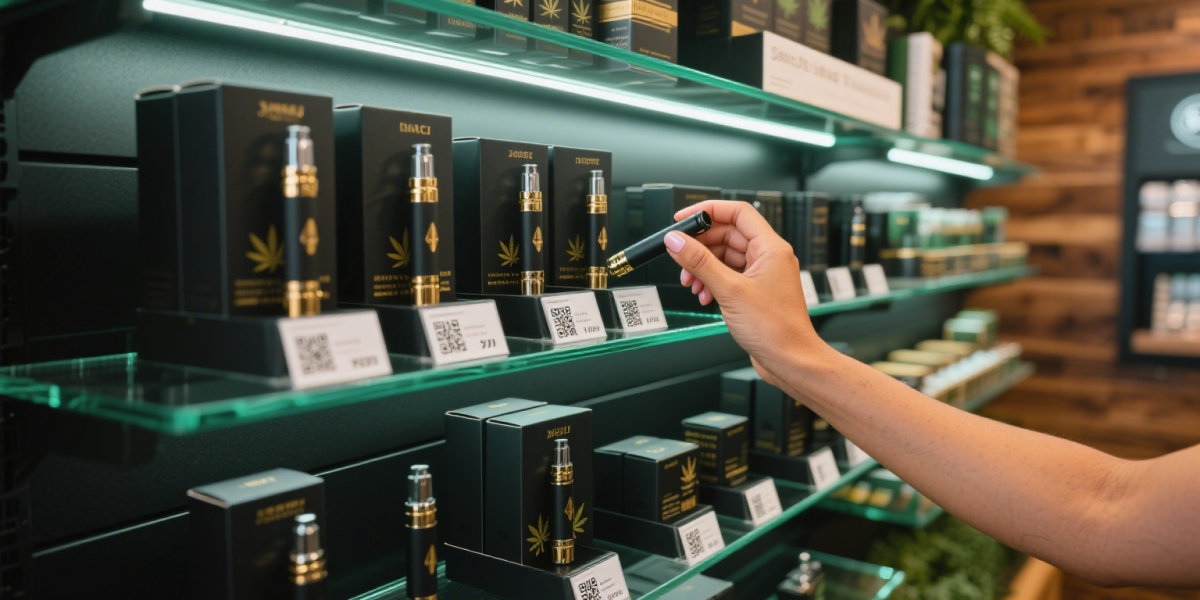The cannabis retail landscape has evolved dramatically from the early days of simple dispensaries to sophisticated retail environments that rival traditional consumer goods stores. In this competitive marketplace, securing optimal shelf placement and driving consistent sales requires strategic thinking that goes far beyond simply delivering quality products to retailers. Success demands understanding the unique dynamics of cannabis retail, building strong partnerships with key stakeholders, and implementing data-driven strategies that benefit everyone in the value chain.
Today's cannabis retailers face intense competition for consumer attention and wallet share. They must carefully curate their product selections to maximize revenue per square foot while serving diverse customer needs and preferences. For vape brands, this reality means that retail success depends as much on strategic partnership development and sales support as it does on product quality and innovation.
Understanding the Cannabis Retail Ecosystem
Cannabis retail operates under unique constraints that don't exist in traditional consumer goods markets. Regulatory requirements limit advertising options, banking restrictions complicate payment processing, and inventory tracking requirements create operational complexities that influence how retailers approach product selection and merchandising.
Successful retailers have learned to maximize the impact of their physical spaces through thoughtful product curation, strategic placement, and comprehensive staff training. They understand that every square inch of retail space must generate sufficient revenue to justify complex compliance requirements and operational overhead that exceed those found in traditional retail.
This environment creates opportunities for vape brands that understand retail dynamics and can provide comprehensive support beyond just product delivery. Retailers value partners who help drive traffic, educate consumers, and simplify operations while maintaining regulatory compliance.
The Science of Product Placement and Category Management
Modern cannabis retailers increasingly apply category management principles borrowed from traditional consumer goods retail. This means analyzing sales data, understanding consumer shopping patterns, and optimizing product placement to maximize category performance rather than focusing solely on individual product sales.
Prime shelf placement – typically at eye level in high-traffic areas – commands premium positioning fees and delivers significantly higher sales velocities. However, securing this placement requires demonstrating strong sales performance, consumer demand, and retailer profitability. Brands that can provide compelling ROI projections for new vape products backed by solid market data have significant advantages in placement negotiations.
Category positioning also influences consumer perception and purchase behavior. Products placed alongside premium brands benefit from association effects, while value-positioned products may perform better when grouped with similar offerings. Understanding these dynamics helps brands negotiate appropriate placement that aligns with their positioning strategy and target customer profile.
Building Retailer Partnerships Through Value Creation
The most successful vape brands approach retail relationships as strategic partnerships rather than transactional vendor relationships. This means understanding retailer challenges and objectives, then developing solutions that address these needs while advancing brand goals.
Retailers consistently cite inventory management, staff training, and customer education as key challenges in cannabis retail. Brands that provide comprehensive solutions in these areas build stronger partnerships and earn preferred vendor status that translates into better placement and increased sales support.
Inventory management support might include demand forecasting assistance, flexible minimum order quantities, or rapid restocking capabilities that help retailers maintain optimal inventory levels without tying up excessive working capital. These services become particularly valuable for retailers managing limited storage space and complex compliance requirements.
Staff Education and Sales Training Programs
Budtender recommendations significantly influence consumer purchase decisions, particularly for new or unfamiliar products. Vape brands that invest in comprehensive staff education programs create competitive advantages while supporting retailer success.
Effective training programs go beyond basic product information to include consumption guidance, comparative positioning, and techniques for identifying appropriate products for different customer needs and experience levels. Well-trained staff can confidently recommend products, handle customer questions, and upsell complementary items.
The most successful training programs are ongoing rather than one-time events. Regular updates about new products, market trends, and selling techniques keep brand awareness high while providing continuing value to retail partners. Digital training platforms and certification programs can scale these efforts efficiently across multiple locations.
Data-Driven Decision Making and Performance Optimization
Modern cannabis retail success requires sophisticated analysis of sales data, consumer behavior, and market trends. Brands that can provide retailers with actionable insights and performance analytics create significant value while building stronger partnerships.
Point-of-sale data analysis reveals important patterns about consumer preferences, purchase timing, and product combinations that can inform inventory decisions and promotional strategies. Brands that help retailers understand these patterns and optimize their operations accordingly become valuable strategic partners.
Category performance analysis helps retailers understand how vape products contribute to overall store profitability, not just direct product margins. Vape purchases often include complementary items like accessories, other cannabis products, or impulse purchases that increase transaction values. Demonstrating these broader impacts helps justify premium placement and supports pricing negotiations.
Promotional Strategies and Marketing Support
Cannabis advertising restrictions create unique challenges for driving consumer awareness and trial. Successful brands develop creative promotional strategies that work within regulatory constraints while providing meaningful support to retail partners.
In-store demonstrations, educational events, and sampling programs (where legally permitted) create opportunities for direct consumer engagement while supporting retailer traffic-building efforts. These activities require careful coordination with retail partners and strict adherence to local regulations, but can significantly impact product awareness and trial rates.
Digital marketing support, including social media content, educational materials, and consumer engagement campaigns, helps retailers extend their marketing reach while maintaining compliance with advertising restrictions. Brands that provide high-quality, compliant marketing assets reduce retailer workload while ensuring consistent brand messaging.
Inventory Management and Supply Chain Excellence
Reliable inventory management and delivery performance form the foundation of strong retail partnerships. Cannabis retailers operate with limited storage space and face significant costs for stockouts or overstock situations, making supplier reliability critical.
Advanced inventory management systems help both brands and retailers optimize stock levels based on sales velocity, seasonal patterns, and promotional activities. These systems can automatically trigger reorders, provide low-stock alerts, and generate performance reports that support data-driven decision making.
Flexible delivery schedules and minimum order quantities help retailers manage cash flow and storage constraints while maintaining adequate inventory levels. Brands that can adapt their logistics to support retailer needs build stronger partnerships and earn preferred supplier status.
Pricing Strategy and Competitive Positioning
Cannabis vape pricing requires careful balance between profitability, competitive positioning, and retailer margin requirements. Successful brands develop pricing strategies that account for the entire value chain while supporting sustainable growth for all stakeholders.
Understanding competitor pricing and positioning helps brands identify opportunities for differentiation and optimal price points. This analysis must consider not just direct competitors but also alternative products that serve similar consumer needs or occasions.
Retailer margin requirements vary significantly across different markets and store formats. Premium retailers with high operational costs may require higher margins than value-focused competitors. Successful brands develop flexible pricing structures that can accommodate different retailer requirements while maintaining brand positioning integrity.
Technology Integration and Operational Efficiency
Modern cannabis retail increasingly relies on technology platforms that integrate point-of-sale systems, inventory management, compliance tracking, and customer relationship management. Vape brands that seamlessly integrate with these systems provide significant operational advantages to retail partners.
Electronic data interchange (EDI) capabilities streamline ordering and inventory management processes while reducing errors and administrative costs. Brands that invest in these integrations demonstrate commitment to operational excellence and long-term partnership development.
Customer relationship management integration helps retailers understand purchase patterns and preferences while supporting targeted marketing efforts. Brands that contribute to these insights through product usage data and market research provide additional value to retail partners.
Measuring and Optimizing Retail Performance
Successful retail partnerships require ongoing performance monitoring and optimization. Key performance indicators (KPIs) should include not just sales volume but also inventory turns, gross margins, customer satisfaction, and category growth contributions.
Regular business reviews with retail partners provide opportunities to analyze performance, identify improvement opportunities, and align on strategic priorities. These reviews should focus on mutual success rather than one-sided vendor reporting, creating collaborative relationships that drive long-term growth.
A/B testing of placement, pricing, and promotional strategies provides valuable insights for optimizing retail performance. Brands that can design and execute these tests while measuring results create competitive advantages while supporting retailer success.
Adapting to Market Evolution and Regulatory Changes
The cannabis retail landscape continues evolving rapidly as markets mature and regulations adapt. Successful brands maintain flexibility in their retail strategies while staying ahead of market trends and regulatory developments.
New market entry requires careful adaptation of retail strategies to local conditions, competitive landscapes, and regulatory requirements. Brands that develop standardized processes with local customization capabilities can scale more efficiently across different markets.
Regulatory changes can significantly impact retail operations, product placement requirements, and marketing restrictions. Brands that help retailers navigate these changes while maintaining compliance build stronger partnerships and competitive advantages.
The relationship between cannabis vape brands and retailers will continue evolving as the market matures and becomes more sophisticated. Success requires understanding that retail partnerships are strategic relationships that benefit from mutual investment, clear communication, and shared commitment to consumer satisfaction.
Brands that approach retail relationships strategically – providing comprehensive support, valuable insights, and operational excellence – will earn preferred status that translates into better placement, increased sales support, and sustainable competitive advantages. In a market where shelf space is limited and competition is intense, these partnerships often determine the difference between success and failure.
The future belongs to brands that can combine quality products with retail excellence, creating value for consumers, retailers, and stakeholders throughout the cannabis value chain.








